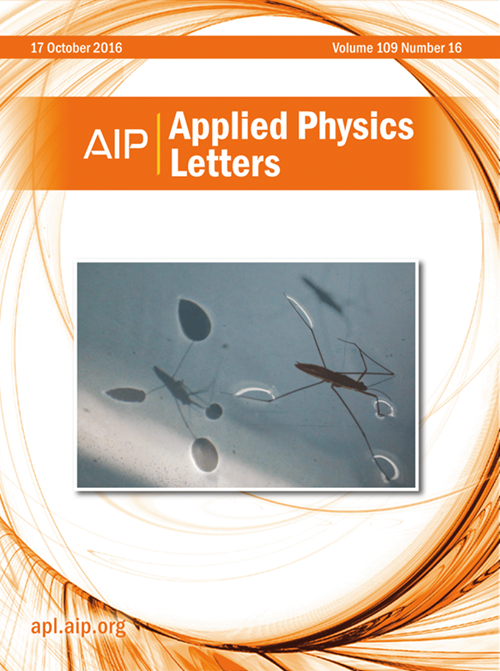微相分离增强全聚合物介电复合材料高温电容储能性能
IF 3.6
2区 物理与天体物理
Q2 PHYSICS, APPLIED
引用次数: 0
摘要
聚合物介质电容器由于其优异的功率密度、高击穿强度、优异的可加工性和成本效益,在现代电子和电力系统中发挥着至关重要的作用。然而,由于传统聚合物电介质固有的热不稳定性,它们在恶劣操作环境中的实际部署仍然具有挑战性,特别是在电动汽车和航空航天电力电子设备中。本文报道了一种由部分混相聚醚酰亚胺(PEI)/聚酰胺酰亚胺(PAI)共混制备的全聚合物介电复合材料(APDC),该材料具有显著改善的高温电容储能性能,包括击穿强度(Eb)、放电能量密度(Ud)和充放电效率(η)。性能的增强源于自组装的纳米级界面结构,包括PEI矩阵内均匀分散的PAI畴,以及PEI和PAI之间的固有能带结构不匹配(特别是在电子亲和方面)。这些结构特征有效地创造了深层电荷陷阱,与高温和高电场下的原始PEI相比,泄漏电流密度大幅降低了一个数量级以上。值得注意的是,开发的APDC材料具有直接,高效和经济的制造工艺,使其在高温电容器的高性能介电膜的可扩展生产中具有很大的前景。本文章由计算机程序翻译,如有差异,请以英文原文为准。
Enhancement of high-temperature capacitive energy storage performance in all-polymer dielectric composites via microphase separation
Polymer dielectric capacitors play a crucial role in modern electronics and power systems owing to their exceptional power density, high breakdown strength, excellent processability, and cost-effectiveness. Nevertheless, their practical deployment in harsh operating environments, particularly in electric vehicles and aerospace power electronics, remains challenging due to the inherent thermal instability of conventional polymer dielectrics. Herein, we report an all-polymer dielectric composite (APDC) material fabricated from partially miscible polyetherimide (PEI)/polyamide-imide (PAI) blends that exhibits significantly improved high-temperature capacitive energy storage properties, including breakdown strength (Eb), discharge energy density (Ud), and charge–discharge efficiency (η). The performance enhancement stems from the self-assembled nanoscale interfacial architectures comprising uniformly dispersed PAI domains within the PEI matrix, coupled with the intrinsic energy band structure mismatch between PEI and PAI (notably in electron affinity). These structural characteristics effectively create deep charge traps, resulting in a substantial reduction of leakage current density by more than one order of magnitude compared to pristine PEI under elevated temperatures and high-electric fields. Notably, the developed APDC materials feature a straightforward, efficient, and cost-effective fabrication process, rendering them highly promising for scalable production of high-performance dielectric films for high-temperature capacitors.
求助全文
通过发布文献求助,成功后即可免费获取论文全文。
去求助
来源期刊

Applied Physics Letters
物理-物理:应用
CiteScore
6.40
自引率
10.00%
发文量
1821
审稿时长
1.6 months
期刊介绍:
Applied Physics Letters (APL) features concise, up-to-date reports on significant new findings in applied physics. Emphasizing rapid dissemination of key data and new physical insights, APL offers prompt publication of new experimental and theoretical papers reporting applications of physics phenomena to all branches of science, engineering, and modern technology.
In addition to regular articles, the journal also publishes invited Fast Track, Perspectives, and in-depth Editorials which report on cutting-edge areas in applied physics.
APL Perspectives are forward-looking invited letters which highlight recent developments or discoveries. Emphasis is placed on very recent developments, potentially disruptive technologies, open questions and possible solutions. They also include a mini-roadmap detailing where the community should direct efforts in order for the phenomena to be viable for application and the challenges associated with meeting that performance threshold. Perspectives are characterized by personal viewpoints and opinions of recognized experts in the field.
Fast Track articles are invited original research articles that report results that are particularly novel and important or provide a significant advancement in an emerging field. Because of the urgency and scientific importance of the work, the peer review process is accelerated. If, during the review process, it becomes apparent that the paper does not meet the Fast Track criterion, it is returned to a normal track.
 求助内容:
求助内容: 应助结果提醒方式:
应助结果提醒方式:


